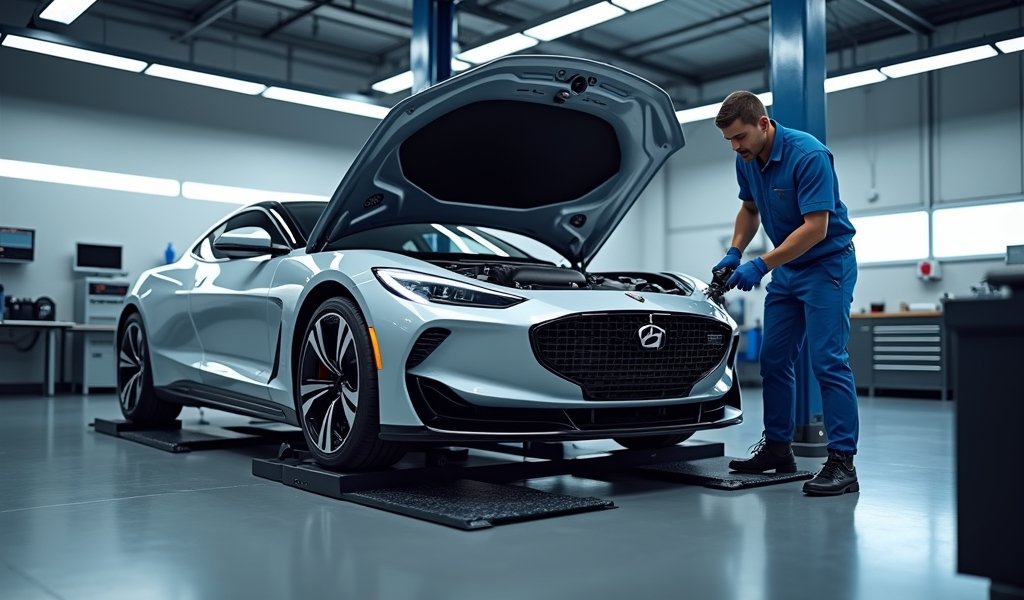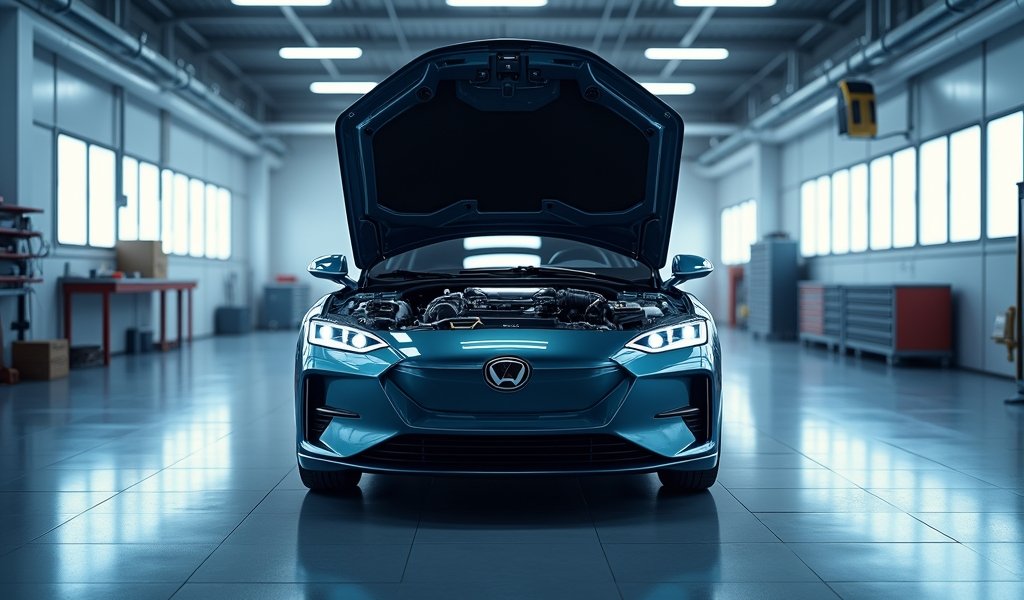Overview
The article provides five essential maintenance tips for hybrid vehicles, covering battery system care, regenerative braking monitoring, cooling system maintenance, engine upkeep, and the importance of using hybrid-specific diagnostic tools. Proper hybrid maintenance requires understanding the dual power systems, following manufacturer recommendations, and finding qualified technicians with specialized hybrid knowledge to ensure optimal performance and longevity.
Table of Contents
- Introduction to Hybrid Car Maintenance
- Understanding Your Hybrid Battery System
- Monitoring Regenerative Braking Performance
- Maintaining the Cooling System Properly
- Regular Engine Maintenance for Hybrids
- Using Hybrid-Specific Diagnostic Tools
- Conclusion
- Frequently Asked Questions
Introduction to Hybrid Car Maintenance
As hybrid vehicles continue to grow in popularity, more drivers are enjoying the benefits of improved fuel efficiency and reduced emissions. But here’s the thing – maintaining these sophisticated machines requires a different approach than conventional vehicles. I’ve been working with hybrids since they first hit the mainstream, and I’m here to share what I’ve learned along the way.
Hybrid cars combine traditional combustion engines with electric motors and sophisticated battery systems. This dual-power setup is brilliant for saving fuel, but it adds complexity when it comes to maintenance. The good news? With the right know-how, keeping your hybrid in top shape isn’t difficult – it’s just different.
The benefits of hybrid vehicles are substantial, from lower fuel costs to reduced environmental impact. According to U.S. Department of Energy research, hybrids typically consume 30-60% less fuel than conventional vehicles. But to maintain these benefits over the long haul, proper maintenance is essential.
Let’s dive into five professional maintenance tips that will help keep your hybrid running at peak performance for years to come. These tips come from years of hands-on experience and represent the most critical aspects of hybrid maintenance that every owner should understand.
Understanding Your Hybrid Battery System

Think of your hybrid’s battery as its heart. Most hybrids use either nickel-metal hydride (NiMH) or lithium-ion batteries, and they’re designed to last a long time – typically 100,000 to 150,000 miles. But like any heart, they need proper care to reach their full potential.
Watching for early warning signs can save you thousands in repair costs. Keep an eye out for decreased fuel economy, as this is often the first indicator that your battery isn’t performing optimally. If you notice your engine running more frequently than usual or see battery warning lights illuminating your dashboard, it’s time to get things checked out.
Here’s what you can do to maintain your hybrid battery:
- Drive regularly – Hybrid batteries don’t like sitting unused for long periods
- Keep battery cooling vents clean and unobstructed
- Avoid frequent rapid acceleration and hard braking when possible
- Schedule professional battery system inspections during regular service intervals
Temperature extremes can significantly impact battery performance. In very hot or cold conditions, try to park in garages or shaded areas when possible. And contrary to popular belief, you don’t need to completely discharge and recharge your hybrid battery – in fact, most hybrid systems are designed to maintain the battery charge within a specific range to maximize longevity.
One customer’s Toyota Prius came in with mysterious power issues after sitting unused for three months during a long vacation. The battery had partially discharged and developed cell imbalance. After a professional reconditioning service, the vehicle returned to full performance – a simple preventive drive every couple of weeks could have avoided the $450 service.
Monitoring Regenerative Braking Performance
One of the coolest features of hybrid vehicles is regenerative braking – it’s like getting free energy every time you slow down. When you ease off the accelerator or lightly press the brake, your hybrid converts that kinetic energy back into electricity, recharging your battery.
Over time, you’ll develop a feel for how your regenerative braking should perform. Pay attention to how quickly your hybrid slows when you lift off the accelerator and watch the energy display on your dashboard. Any significant changes in this behavior warrant attention.
Signs your regenerative braking system needs attention include:
- Diminished slowing effect when lifting off the accelerator
- Reduced energy recovery readings on your dashboard display
- Conventional brake pads wearing faster than expected
- Unusual sounds during deceleration
The beauty of regenerative braking is that it significantly reduces wear on your conventional brakes. Many hybrid owners are surprised (and delighted) to learn their brake pads might last 75,000 miles or more with proper driving habits. To maximize this benefit, practice smooth, gradual braking whenever possible.
If your vehicle has different driving modes, experiment with them to find the optimal regenerative braking setting for different conditions. Many newer hybrids have a “B” mode that increases engine braking and energy recovery – perfect for downhill driving or stop-and-go traffic.
Maintaining the Cooling System Properly
Hybrids typically have dual cooling systems – one for the engine and another for the electric components and battery. Both are crucial for peak performance and longevity. Temperature management in hybrids is particularly critical because excessive heat is the enemy of battery life.
Unlike traditional vehicles, hybrid cooling systems often continue operating even after you’ve turned off your car. This is normal and necessary to protect the battery and power electronics. If you notice the cooling fan running for extended periods after shutting down, however, it might indicate a problem that needs attention.
For proper cooling system maintenance:
- Check coolant levels monthly, ensuring both systems maintain proper fluid levels
- Have cooling systems inspected during your regular service intervals
- Clean radiator and cooling fins annually to remove debris
- Replace coolant according to manufacturer schedules, typically every 50,000-100,000 miles
Some hybrid models use specialized coolant for their battery cooling systems. Using the wrong type can damage expensive components, so always confirm you’re using manufacturer-approved fluids. This is one area where following the manual to the letter pays dividends.
I once had a customer whose hybrid battery failed prematurely at just 85,000 miles. The culprit? A partially clogged cooling system that had been allowing the battery to overheat during summer commutes. A simple cooling system service might have prevented a $3,000 battery replacement. Don’t let this happen to you!
Regular Engine Maintenance for Hybrids

It’s easy to forget that your hybrid still has a traditional engine that needs regular care. In fact, the way hybrids operate – with frequent starting and stopping – creates some unique maintenance considerations.
Because hybrid engines often run less frequently and sometimes at lower temperatures than conventional vehicles, they can develop issues with oil dilution and moisture buildup. This is why most manufacturers recommend synthetic oil for hybrids – it provides better protection under these specific operating conditions.
Follow these engine maintenance best practices:
- Stick to your manufacturer-recommended oil change intervals, typically every 7,500-10,000 miles
- Use high-quality synthetic oil specified for your hybrid model
- Keep your gas tank at least quarter-full to minimize condensation
- Consider fuel system cleaners every 15,000 miles to prevent carbon buildup
One maintenance tip that surprises many hybrid owners: occasionally taking your hybrid on longer drives (30+ minutes at highway speeds) can be beneficial. These extended runs allow the engine to reach full operating temperature and run continuously, helping clear out carbon deposits and ensuring all engine components remain properly lubricated.
Hybrid engines develop unique carbon buildup patterns because of their intermittent operation. According to research from the Society of Automotive Engineers, direct-injection engines in hybrids are particularly susceptible to intake valve deposits. Regular highway driving and top-tier fuels can help mitigate this issue.
Using Hybrid-Specific Diagnostic Tools
One of the biggest mistakes I see is hybrid owners bringing their vehicles to shops that lack hybrid-specific diagnostic equipment. Your sophisticated hybrid deserves better than generic OBD-II scanners that can’t fully access or properly interpret hybrid system data.
For DIY monitoring between service visits, consider investing in an OBD-II scanner with hybrid-specific capabilities. These tools can provide insights into battery health, regenerative braking performance, and overall system efficiency. Just remember that consumer-grade tools only scratch the surface compared to professional equipment.
When seeking professional service for your hybrid:
- Look for technicians with specific hybrid training and certification
- Ask about their hybrid-specific diagnostic equipment
- Inquire about their experience with your specific make and model
- Confirm they stay updated on manufacturer service bulletins for hybrid systems
I’ve seen countless cases where general mechanics misdiagnosed hybrid issues, leading to unnecessary repairs or missed problems. In one memorable case, a customer had been told they needed a new battery when the real issue was a simple coolant sensor that any hybrid specialist would have identified immediately.
Remember, paying a bit more for a qualified hybrid specialist often saves money in the long run by ensuring accurate diagnosis and proper repairs. Good hybrid technicians combine traditional automotive knowledge with specialized electrical system expertise – a valuable combination that’s worth seeking out.
Conclusion
Maintaining your hybrid vehicle doesn’t have to be intimidating. With these five professional tips – understanding your battery system, monitoring regenerative braking, maintaining cooling systems, keeping up with engine maintenance, and using proper diagnostic tools – you’re well equipped to keep your hybrid performing at its best for years to come.
Remember that hybrids are designed for efficiency and longevity. When properly maintained, they typically offer lower overall operating costs than conventional vehicles. The key is understanding their unique requirements and addressing them proactively.
At Knows Your Car, we’re committed to helping hybrid owners maintain their vehicles through education, appropriate diagnostic tools, and connections to qualified service providers. Your hybrid represents a significant investment in sustainable transportation, and these maintenance practices will help ensure it delivers the performance, efficiency, and reliability you expect.
Have questions about your hybrid’s maintenance needs? Need help finding the right diagnostic tools or qualified service providers? We’re here to help you navigate the unique aspects of hybrid ownership with confidence and ease.
Frequently Asked Questions
How often should I change the oil in my hybrid vehicle?
Most hybrid manufacturers recommend oil changes every 7,500-10,000 miles. Always use the manufacturer-recommended synthetic oil for best results.
Do hybrid batteries need special maintenance?
Hybrid batteries primarily need regular use and proper cooling to maintain health. Avoid extended periods of disuse and ensure cooling vents remain clean and unobstructed.
How long do hybrid batteries typically last?
Most hybrid batteries last between 100,000-150,000 miles, though many exceed 200,000 miles with proper care. Modern hybrids often have battery warranties covering 8-10 years or 100,000 miles.
Can I jump-start a hybrid car like a conventional vehicle?
Yes, but with caution. Hybrids have a conventional 12V battery that can be jump-started following the manufacturer’s specific procedure, which may differ from traditional vehicles.
Are hybrid vehicles more expensive to maintain than conventional cars?
Properly maintained hybrids typically cost less overall due to reduced brake wear and less frequent engine maintenance. The key is finding qualified technicians for any hybrid-specific issues that arise.


Pingback: Hybrid Car Maintenance Guide: Top 7 Tips - knowsyourcar.com